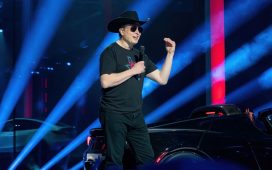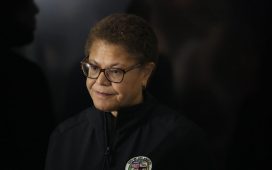Q: When do you expect the chip shortage to resolve and production to normalize?
A: I think it’s normalizing as we go. This year, the start, has been better than what we experienced last year. I’m really proud of the team and what they’ve done day in, day out to respond to whatever the circumstance is. Our idea is to make the most of every vehicle that we can build. And I think we’re doing that. We’ve learned a lot through all that in terms of operating on a very lean basis.
Last year you said that GM would not abandon internal combustion if consumer demand was there. Any changes to that mindset?
Not at all. As we’re having this conversation, we’re rolling out the midcycle version of our pickups, Silverado and Sierra. We’ve also got a really awesome change of the Colorado and Canyon coming just around the corner. We’ve got an awesome ICE portfolio. We’re very proud of it. We’re investing in all that because it’s what people want. We’ll do that for a period of time and continue to be poised for the transition.
The consumer propensity to consider EVs is only increasing, especially now in light of the escalation in fuel prices and other commodities. In all of the market research that we do for EVs, we’re always putting EVs in against their competitive set, but also their most equivalent ICE counterparts. We’re seeing a very steady progression of consumers more interested and more willing to consider EVs in almost every clinic that we do.
Will GM adjust the dealership distribution model?
Part of what we’re doing is putting regional distribution centers in place so that the dealer can pull from their regional distribution center. And you combine that with focused ordering. So you have a good idea that what’s in that regional distribution center is what the consumer is going to want. We’re going to work that out on the Bolt and Bolt EUV first, as well as CarBravo. A lot of these innovations have come through over the course of the last couple of years. We’re really seeing them start to not just pay off for the current situation, but the opportunity for them to pay forward in the future.
Last year you said GM would question all of the fundamentals of the retail process. What changes have you made to retail operations over the last year?
It’s under the category of running lean. We know all the factors that contributed to that: COVID, semiconductors and everything. [We are] working with our dealers because they’ve enjoyed some pretty good profitability over the last couple of years. The question we ask ourselves — and we work with them on it — is, now that we’re here, how did we get here and how can we carry that forward? A profitable dealer is going to be a great customer experience.
Another area I’d mention is the digital retail platform. [The pandemic] sure accelerated the development of our shopping tool. And then we went omnichannel with our digital retail platform. A lot of those things have been accelerated because of everything that we’ve been through. Every month, there’s a new challenge. Every month, there’s also a new solution. It keeps getting better.
Are regional distribution centers a long-term solution?
We’re planning for it to be a long-term process. What people like about dealerships and dealer lots is that they like to be able to go and see, touch, feel and test drive. That will be there. The opportunity here is how many [vehicles] do you need at a dealership? Probably a lot less than we have had in the past.
What’s the benefit of these centers to GM and the dealers?
Less wholesale for floorplan costs. In the form of supply, less physical assets tied up in inventory and less damage and less lot rot and less warranty. Having essentially operated that way for an extended period of time, we can see the benefits of it. Certainly we’re not going to be operating as lean as we are now. But some of these distribution centers [will be] closer to the dealer so that when they need them, they can draw from them and not have to wait for the whole normal cycle. It takes a lot of cost out, a lot of waste out of the system and improves responsiveness and is even a positive to dealer profitability and ours because we participate in floorplanning.
Do you consider reservations to be a long-term sales model?
That’s a very dynamic situation. It will evolve. Some form of reservations will be with us for a while. They’ve already been refined. It started out a little bit independent from the normal kind of ordering process for a bunch of reasons. I think over time it’ll get a lot more connected to it. If you get a new hot product, you want to be in that as soon as you can. You want to get in line for that. Other products, maybe not so much. You’re ready to wait until they’re in production. We need to recognize that full spectrum and continue to evolve it and continue to work on the compatibility of it with the allocation process. But there are a lot of reasons why you want to do it. You want to be able to tap into the enthusiasm for these hot products.
Are fleet and commercial customers considering EVs?
We [have been talking to] 300-plus of our bigger account partners about Silverado EV and Equinox EV and Blazer EVs and certainly BrightDrop. And that conversation has changed a lot. If it was “if” two years ago, we’re well into the “when” now.
Over the last 12 months, that’s progressed tremendously. And I think it’ll do a lot to help promote the transition in total because that’ll put a lot more EVs on the road sooner. That’s part of the adoption process. You believe it if you can see it. It also helps the industry to validate that they’re up to the job from a durability and reliability point of view.
Explain GM’s EV charging infrastructure initiatives.
We’re approaching it at three levels. There’s the home, workplace, public and road trip charging. The community charging is where our dealers fit in. So to size that, our goal is to take 40,000 Level 2 chargers and work with our dealers to have those installed in your local communities. Dealers have the relationships in the community, and the community is going to know where they want to put the charger. We’re getting really close to signing up with some partners so that you can travel the interstate system and be confident that you’re going to a charger that works and charges fast. And then we’re continuing on with EVgo and others so that we can network existing chargers.
We’re investing about $750 million so far. I’ve got to think it was a little like back in the ’20s and ’30s when we started to think about the interstate highway system and building out a gasoline station network.
What will GM do if limited battery supply slows the ability to build EVs?
We’re going to work very hard to prevent it from becoming a constraint. We’re undertaking a series of initiatives on that, and that’s been sparked by what we’ve seen with other shortages like semiconductors, COVID, trade frictions, all sorts of things going on in the world. When we look at the raw materials that go into making a battery, what’s the best place to source that from and from whom to source it. We have made a handful of really important partnerships in the last little while.
We’re building out the supply chain, back to the mine, through the processing and post-processing and sourcing those in parts of the world where they are as safe, accessible and environmentally responsible as possible.








